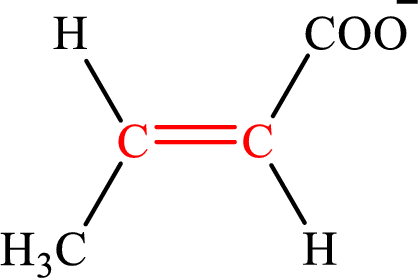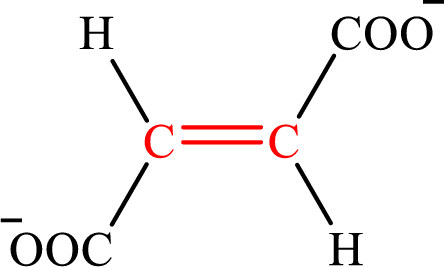
Concept explainers
(a)
Interpretation:
The citric acid cycle diacid intermediate counterpart for lipogenesis C4-ACP monoacid intermediate butyrate has to be determined.
Concept introduction:
Lipogenesis is the process employed for the synthesis of fatty acid. The starting precursor for the synthesis is acetyl CoA. The enzyme employed for the process is fatty acid synthase. It is a multienzyme complex that ties the reaction responsible for the synthesis of fatty acid. This process is the reverse of the degradation of fatty acid.
The Citric acid cycle is a series of biochemical reactions that use acetyl CoA (produced by oxidation of pyruvate) to produce carbon dioxide, NADH and FADH2 in a series of
(a)
Answer to Problem 25.105EP
The citric acid cycle diacid intermediate counterpart for lipogenesis C4-ACP monoacid butyrate intermediate is succinate.
Explanation of Solution
Intermediates involved in the lipogenesis are derivative of C4 molecule butyric acid. Butyric acid is a monocarboxylic acid and has 4 carbon atoms. Thus, each intermediate of the lipogenesis is a C4 derivative of monocarboxylic acid. The structure of butyric acid is,

Succinic acid is a dicarboxylic acid and has 4 carbon atoms. Thus, each intermediate of the citric acid cycle is a

The structure of butyrate is,

The structure of succinate is,

Butyrate and succinate are saturated acids with four carbon atoms in each molecule. Butyrate is a monoacid that is formed as an intermediate in lipogenesis while succinate is a diacid that is formed as an intermediate in the citric acid cycle. Therefore, the citric acid cycle diacid intermediate counterpart for lipogenesis C4-ACP monoacid butyrate intermediate is succinate.
(b)
Interpretation:
The citric acid cycle diacid intermediate counterpart for lipogenesis C4-ACP monoacid intermediate acetoacetate has to be determined.
Concept introduction:
Lipogenesis is the process employed for the synthesis of fatty acid. The starting precursor for the synthesis is acetyl CoA. The enzyme employed for the process is fatty acid synthase. It is a multienzyme complex that ties the reaction responsible for the synthesis of fatty acid. This process is the reverse of the degradation of fatty acid.
The Citric acid cycle is a series of biochemical reactions that use acetyl CoA (produced by oxidation of pyruvate) to produce carbon dioxide, NADH and FADH2 in a series of redox reactions.
Intermediates involved in the lipogenesis are derivatives of C4 molecule butyric acid. Butyric acid is a monocarboxylic acid and has 4 carbon atoms. Thus, each intermediate of the lipogenesis is a C4 derivative of monocarboxylic acid. The structure of butyric acid is,

Succinic acid is a dicarboxylic acid and has 4 carbon atoms. Thus, each intermediate of the citric acid cycle is a C4 derivative of dicarboxylic acid. The structure of succinic acid is,

(b)
Answer to Problem 25.105EP
The citric acid cycle diacid intermediate counterpart for lipogenesis C4-ACP monoacid acetoacetate intermediate is oxaloacetate.
Explanation of Solution
Acetoacetate is the intermediate in the lipogenesis. The structure of acetoacetate is,

Oxaloacetate is the intermediate in the citric acid cycle. The structure of oxaloacetate is,

Acetoacetate and oxaloacetate are the keto derivatives of saturated acid with four carbon atoms in each molecule. Acetoacetate is a keto derivative of monocarboxylic acid while oxaloacetate is a keto derivative of dicarboxylic acid. Therefore, the citric acid cycle diacid intermediate counterpart for lipogenesis C4-ACP monoacid acetoacetate intermediate is oxaloacetate.
(c)
Interpretation:
The citric acid cycle diacid intermediate counterpart for lipogenesis C4-ACP monoacid intermediate β-hydroxybutyrate has to be determined.
Concept introduction:
Lipogenesis is the process employed for the synthesis of fatty acid. The starting precursor for the synthesis is acetyl CoA. The enzyme employed for the process is fatty acid synthase. It is a multienzyme complex that ties the reaction responsible for the synthesis of fatty acid. This process is the reverse of the degradation of fatty acid.
The Citric acid cycle is a series of biochemical reactions that use acetyl CoA (produced by oxidation of pyruvate) to produce carbon dioxide, NADH and FADH2 in a series of redox reactions.
Intermediates involved in the lipogenesis are derivatives of C4 molecule butyric acid. Butyric acid is a monocarboxylic acid and has 4 carbon atoms. Thus, each intermediate of the lipogenesis is a C4 derivative of monocarboxylic acid. The structure of butyric acid is,

Succinic acid is a dicarboxylic acid and has 4 carbon atoms. Thus, each intermediate of the citric acid cycle is a C4 derivative of dicarboxylic acid. The structure of succinic acid is,

(c)
Answer to Problem 25.105EP
The citric acid cycle diacid intermediate counterpart for lipogenesis C4-ACP monoacid β-hydroxybutyrate intermediate is malate.
Explanation of Solution
β-Hydroxybutyrate is the intermediate in the lipogenesis. The structure of β-hydroxybutyrate is,

Malate is the intermediate in the citric acid cycle. The structure of Malate is,

β-Hydroxybutyrate and malate are the hydroxy derivatives of saturated acid with four carbon atoms in each molecule. β-Hydroxybutyrate is a hydroxy derivative of monocarboxylic acid while malate is a hydroxy derivative of dicarboxylic acid. Therefore, the citric acid cycle diacid intermediate counterpart for lipogenesis C4-ACP monoacid β-hydroxybutyrate intermediate is malate.
(d)
Interpretation:
The citric acid cycle diacid intermediate counterpart for lipogenesis C4-ACP monoacid intermediate crotonate has to be determined.
Concept introduction:
Lipogenesis is the process employed for the synthesis of fatty acid. The starting precursor for the synthesis is acetyl CoA. The enzyme employed for the process is fatty acid synthase. It is a multienzyme complex that ties the reaction responsible for the synthesis of fatty acid. This process is the reverse of the degradation of fatty acid.
The Citric acid cycle is a series of biochemical reactions that use acetyl CoA (produced by oxidation of pyruvate) to produce carbon dioxide, NADH and FADH2 in a series of redox reactions.
Intermediates involved in the lipogenesis are derivatives of C4 molecule butyric acid. Butyric acid is a monocarboxylic acid and has 4 carbon atoms. Thus, each intermediate of the lipogenesis is a C4 derivative of monocarboxylic acid. The structure of butyric acid is,

Succinic acid is a dicarboxylic acid and has 4 carbon atoms. Thus, each intermediate of the citric acid cycle is a C4 derivative of dicarboxylic acid. The structure of succinic acid is,

(d)
Answer to Problem 25.105EP
The citric acid cycle diacid intermediate counterpart for lipogenesis C4-ACP monoacid crotonate intermediate is fumarate.
Explanation of Solution
Crotonate is the intermediate in the lipogenesis. The structure of crotonate is,

Fumarate is the intermediate in the citric acid cycle. The structure of fumarate is,

Crotonate and fumarate are the unsaturated derivatives of a
Want to see more full solutions like this?
Chapter 25 Solutions
General, Organic, and Biological Chemistry
- Five coenzymes are required by a-ketoglutarate dehydrogenase, the enzyme in the citric acid cycle that converts a-ketoglutarate to succinyl-CoA.a. Identify the coenzymes.b. Propose a mechanism for the reaction. A-ketoglutarate dehydrogenase A-ketoglutarate succinyl-CoAOO OO O−O O− −O SCoA + CO2arrow_forwardThe initial step of the citric acid cycle is a. Conversion of pyruvate to acetyl-CoA b. Formation of ? -ketoglutarate catalysed by isocitrate dehydrogenase c. Condensation of acetyl-CoA with oxaloacetate d. Conversion of citrate to isocitratearrow_forwardConsidering the complete oxidation of an 18-C fatty acid. Give the answer for the following question.a. How many rounds of beta-oxidation is needed?b. How many NADH molecules are produced in beta-oxidation only?c. How many FADH2 molecules are produced in beta-oxidation only?d. How many Acetyl Co-A are produced?arrow_forward
- Consider the docosanoic acid, C21H43CO2H a. Label the a and B carbons b. Draw the acyl CoA derived from this fatty acid c. How many acetyl CoA molecules are formed by complete B-oxidation? d. How many cycles of B-oxidation are needed for complete oxidation? e. How many molecules of ATP are formed from the complete catabolism of this fatty acid?arrow_forwardLipases break down triacylglycerols by catalyzing hydrolysis. What are the products of this hydrolysis?arrow_forwardFor myristic acid, C 13H 27CO 2H: (a) How many molecules of acetyl CoA are formed from complete β-oxidation? (b) How many cycles of β-oxidation are needed for complete oxidation?arrow_forward
- In considering the carbohydrate maltose... a. How many molecules of acetyl CoA are formed from its complete catabolism? b. How many rounds of Citric acid Cycle must occur to complete catabolism? c. How many rounds of electron transport chain and oxidative phosphorylation?arrow_forwardThe rate-limiting step in fatty acid synthesis is: a. The reduction of the acetoacetyl group to a ?-hydroxybutyryl group b. Formation of malonyl-CoA from malonate and coenzyme A. c. Condensation of acetyl-CoA and malonyl-CoA. d. The reaction catalyzed by acetyl-CoA carboxylase.arrow_forwardComplete the table below. Consider docosanoic acid (C21H43CO2H) Questions Show complete solutions Answers a. How many acetyl CoA molecules are formed by complete B-oxidation? b. How many cycles of B-oxidation are needed for complete oxidation? c. How many molecules of ATP are formed from the complete catabolism of this fatty acid?arrow_forward
- Considering that triacylglycerols get hydrolyzed in the small intestine because of pancreatic lipases, write the reactions using structural formulas by which a 7-carbon fatty acid is activated and oxidized in the liver of this patient. Indicate cofactors and underscore the final CoA products.arrow_forwardComplete the table below. Consider docosanoic acid (C21H43CO2H) Questions Solutions Answers a. Label the alpha and beta carbons. b. Draw the acetyl CoA derived from this fatty acid. c. How many acetyl CoA molecules are formed by complete B-oxidation? d. How many cycles of B-oxidation are needed for complete oxidation? e. How many molecules of ATP are formed from the complete catabolism of this fatty acid?arrow_forwardWhat is the role of HMG CoA reductase in cholesterol and isoprenoid synthesis?arrow_forward
 BiochemistryBiochemistryISBN:9781305577206Author:Reginald H. Garrett, Charles M. GrishamPublisher:Cengage Learning
BiochemistryBiochemistryISBN:9781305577206Author:Reginald H. Garrett, Charles M. GrishamPublisher:Cengage Learning
